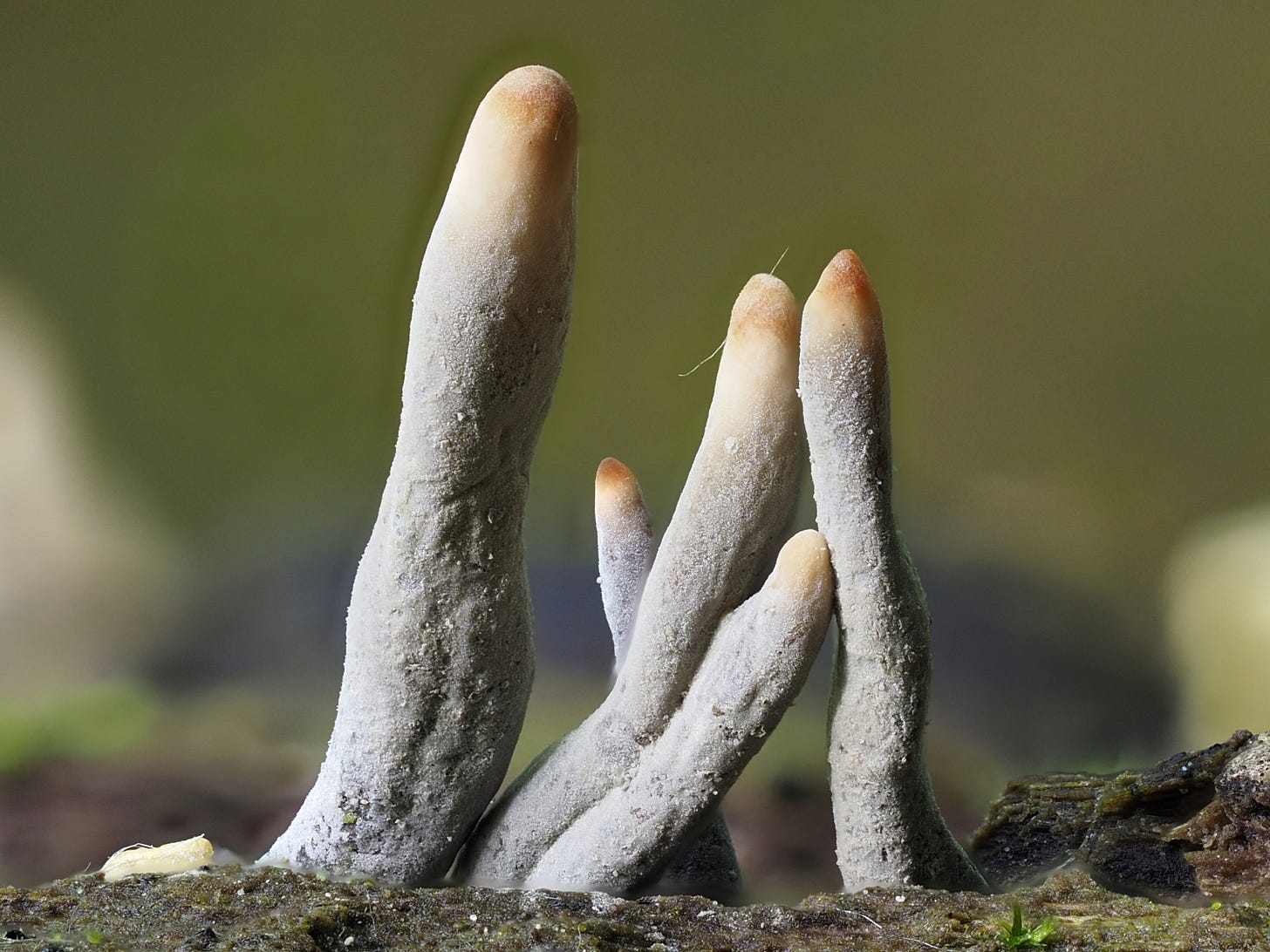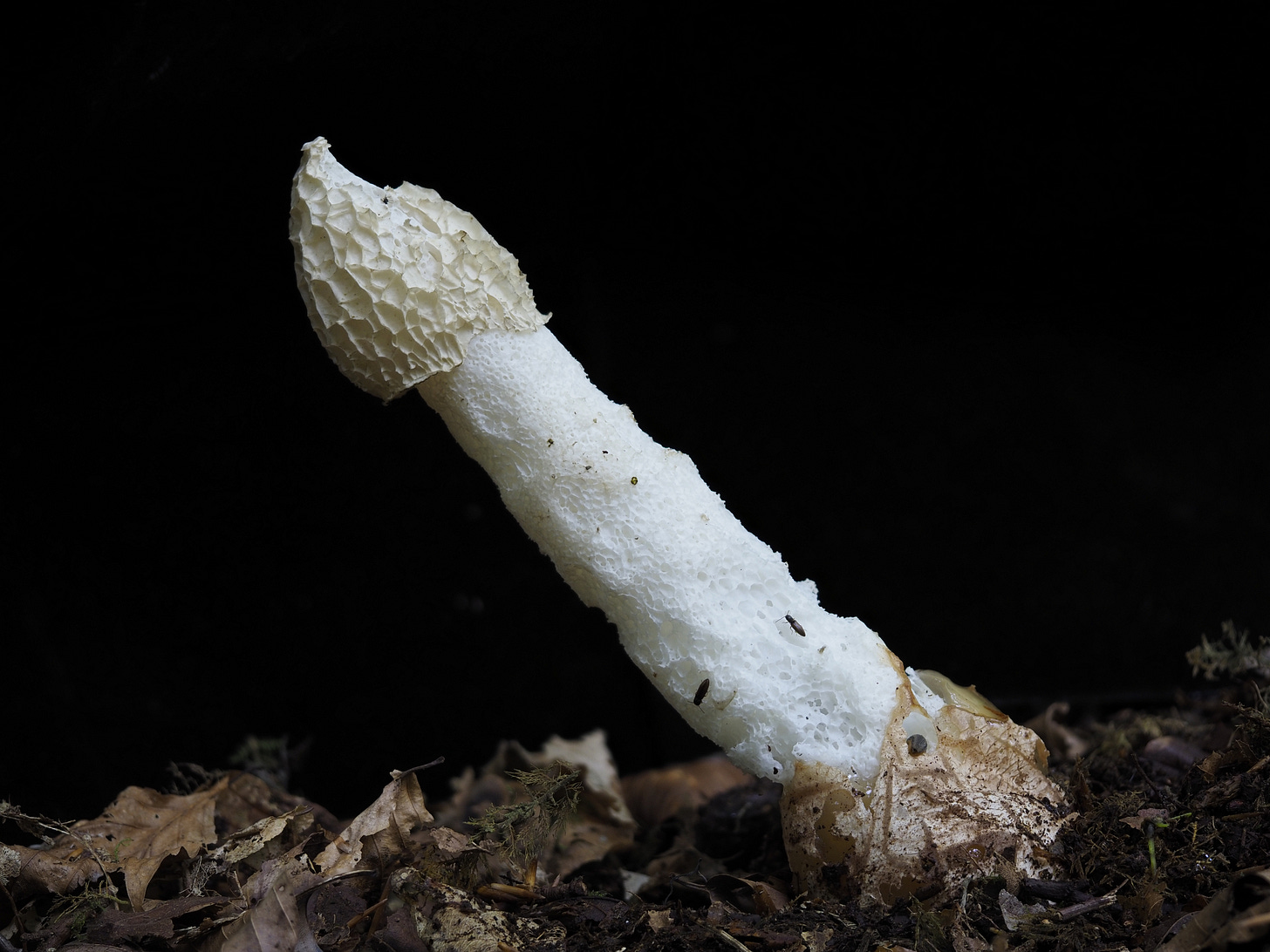A Summer Foray in Scotland
Mushroom hunting Golden Chanterelles, Boletes, Popcorn Oysters, and more.
I spent most of my time in Scotland just outside Glasgow in small towns like Largs, West Kilbride, Irvine, on the Isle of Bute, and wild camping on the Isle of Arran. Below are some of my finds from forays between May and July.
West Kilbride
Dubbed the "Craft Town" of Scotland, I settled into this quaint village for a few weeks at an Airbnb. In the evenings, I'd walk down to Glenn Park just in the middle of town and scan the understory and sides of the tracks. Delightful footpaths weave through the trees and run alongside the Kilbride Burn.
One of the most prevalent mushrooms was Auricularia auricula-judae which could be found covering fallen branches throughout the park. Shaped like an ear, this mushroom made it appear as if the trees were listening.
The specific epithet is derived from the belief that Judas Iscariot hanged himself from an elder tree. It was used in folk medicine as recently as the 19th century for complaints including sore throats, eyes, and jaundice, and as an astringent.
Xylaria
Uncanny-looking mushrooms, anthropomorphized as human body parts such as the jelly ears and dead man's fingers, reach out from dead logs.
These Xylaria species go by other names like stag's horn and candle-snuff fungus.
The name comes from the Greek xýlon, meaning wood, and polymorpha means "many forms." As its name suggests, it has a very variable but often club-shaped fruiting body (stroma) resembling burned wood.
Most Xylaria had the texture of dried-out skin or cracked salt flats. When zooming in closer, smaller growths formed - I'm assuming these are endophytes.
Xylaria was so abundant that I wouldn't pay much attention to them after a while. Still, one thin, small, and spindly species, Xylaria carpophila, was especially unique because it grows only from beechnuts.
Coprinellus micaceus (mica cap)
These are delicate, and most had nibbled bits and evidence of slugs or other insects, so it was rare to get fully intact shots.
The entire cap surface is coated with a fine layer of reflective mica-like cells.
Micas are a group of silicate minerals often used in cosmetics to add "shimmer" or "frost." Other common names for the mushroom are shiny cap or glistening inky cap.
Myxomycetes / Slime Molds
A more interestingly shaped find was a slime mold (not a fungus, but a myxomycete). This uvula (that thing that dangles in the back of your throat) is a species of Stemonitis covering a bit of rotting wood. Stemonitis are common and change color depending on age.
Very small Lycogala epidendrum, Wolf's Milk, or Groening's slime dot rotten logs and stumps. These aethalia are small, pink to brown cushion-like blobs. They may ooze a pink "paste" if the outer wall is broken before maturity. When mature, the color tends to become more brownish.
If you're feeling like a kid, which is the case if you're out mushroom hunting - using a twig to poke these dots can be quite entertaining as a shot of bright pink or orange toothpaste-like gel explodes from the inside.
Popcorn Oysters
There were spots I'd periodically check at Glen Park. Near the creek, a tree stump sat covered entirely in small to medium-sized Pleurotus cornucopiae or Branching Oyster mushrooms. Over the week, these oysters would progressively get larger, and it was lucky to get there in time before slugs, and other insects consumed them.
I harvested enough to fry up by adding oil, butter, and salt. They reduced in size, and the taste immediately reminded me of popcorn. When looking up more info, I wasn't surprised to see that another common name for the species was "Popcorn Oyster." One of the better-tasting mushrooms I've had.
Used to only spotting white, yellow, or brown-colored mushrooms - it was exciting to finally spot a familiar dark purple Russula sp. aka "Brittlegills." There are over 750 species of Russula, and I would find other shades of red, pink, and a blueish-gray "Charcoal Burner."
North Sannox - Glen Rosa
Taking the bus to Ardrossan and catching the ferry, we landed in Brodick within an hour. Another bus was conveniently waiting outside the ferry, and we caught this up to North Sannox, where we'd be wild camping on the beach that evening.
Exhausted, we pitched the tent on the tiny bit of flat grass we could find and set up camp for the next couple of nights. Just along the coast and up the stream that poured out into the sea, native bush remained.
We would later walk up the road about 30 minutes to the North Sannox Glen and set up camp in the pine forest that provided shelter from the wind and rain and midges!
A three-night stay here allowed me to thoroughly comb the forest floor and find various edible and new-to-me species.
The most abundant amongst the pines were Larch Boletes. The caps were viscous and bright orange-red. I would harvest some to fry up. They were reduced to a slippery-like texture with just a hint of butter taste.
At the top of my bucket list were Bog Beacons - little yellow lights that poke out from the swampy, boggy ground.

We'd catch the bus back to Brodick and then hike up to the Glen Rosa campsite. The 7km circuit was barren as the hike was along a stream and into a glacially carved valley with no trees. Only at the end of the hike, Amanita and Boletes were found by the hundreds popping up from the underbrush in a pine forest.
I had finally found Scarletina Bolete, and when cut in half, the stipe turned from a bright yellow to a dark blue.
The pale chanterelle is considered an excellent edible. It is used in numerous dishes like other mushrooms of Cantharellus, but this one is much meatier. It is one of the most famous mushrooms among gourmets, especially among the French.
Rothesay
Rothesay would be my final foray, as our time in Scotland was coming to an end. The Skeoch Wood was a nice escape from the road, opposite Argyle Place.
The Woodland Walk was one of the most productive forays during the entire time I spent in the country, with heaps of mushrooms of all shapes and sizes. I would spend two days out here, and both forays offered new finds.
One of the weirdest (and suggestive) species found was Phallus impudicus, or common stinkhorn.
At the egg stage, pieces of the inner layer (the receptaculum) can be cut out with a knife and eaten raw. They are crisp and crunchy with an attractive radish taste. The fungus is enjoyed and eaten in France and parts of Germany, where it may be sold fresh or pickled and used in sausages. Similar species are consumed in China.
In Northern Montenegro, peasants rub Phallus impudicus on the necks of bulls before bullfighting contests in an attempt to make them stronger. They are also fed to young bulls as they are thought to be a potent aphrodisiac.
In 1777, the reverend John Lightfoot wrote that the people of Thuringia called the unopened stinkhorns "ghost's or daemon's eggs" and dried and powdered them before mixing them in spirits as an aphrodisiac.
Gwen Raverat (granddaughter of Charles Darwin) describes the 'sport' of stinkhorn hunting:
In our native woods, there grows a kind of toadstool, called in the vernacular The Stinkhorn, though, in Latin, it bears a grosser name. The name is justified, for the fungus can be hunted by the scent alone, and this was Aunt Etty's great invention.
Armed with a basket and a pointed stick and wearing a special hunting cloak and gloves, she would sniff her way round the wood, pausing here and there, her nostrils twitching, when she caught a whiff of her prey; then, at last, with a deadly pounce, she would fall upon her victim and poke his putrid carcass into her basket.
At the end of the day's sport, the catch was brought back and burnt in the deepest secrecy on the drawing-room fire, with the door locked; because of the morals of the maids.




























Great article. The Swamp Beacon looks like a peperoncini pepper!